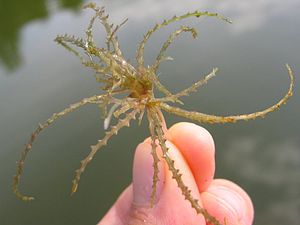Large mermaid
| Large mermaid | ||||||||||||
|---|---|---|---|---|---|---|---|---|---|---|---|---|

Great mermaid ( Najas marina ) |
||||||||||||
| Systematics | ||||||||||||
|
||||||||||||
| Scientific name | ||||||||||||
| Najas marina | ||||||||||||
| L. |
The Great Naiad ( Najas marina ), also marine Naiad or Large Nixkraut called, is a species of the genus mermaids herbs ( Najas ) within the family of hydrocharitaceae (Hydrocharitaceae). It is an underwater plant .
Description and ecology
The great mermaid is an annual herbaceous plant that reaches growth lengths of 10 to 50 centimeters. It has stiff, forked and fragile stems . The constantly against standing on the stems leaves are linear, 1 to 6 millimeters wide, roughly corrugated and prickly perforated.
The great mermaid is dioecious, separate sexes ( diocesan ). The flowers appearing under water are inconspicuous. The male flower, 1.7 to 3 millimeters long, consists of only one stamen . The female, 2.5 to 5.7 millimeters long flower contains a 1.2 to 1.7 millimeter long stylus that ends with a three-lobed stigma. The flowers are pollinated under water.
The reddish-brown nut fruit is egg-shaped with a length of 2.2 to 8 millimeters and a width of 1.2 to 2.5 millimeters. It is mainly spread endozoic by ducks . The large mermaid uses the digestive spread as a spreading strategy . The fruit can pass through the digestive system of ducks undamaged.
The number of chromosomes is 2n = 12, less often 14.
Occurrence
The great mermaid occurs worldwide in subtropical and temperate zones, mainly in the northern hemisphere : North America , Latin America and Eurasia .
It colonizes stagnant or slowly flowing water up to a water depth of 3 meters. Like all mermaid herbs , the great mermaid thrives in fresh water. However, it can also be found in the brackish water of the Baltic Sea in Sweden and Denmark . In the more salty North Sea, however, the great mermaid is missing. Overall, the great mermaid is rarely found and is on the decline due to water pollution . It is a character species of the Potamogetoneto-Najadetum marinae from the Potamogetonion association.
Systematics
Depending on the author, there are four subspecies and several varieties of Najas marina :
- Najas marina subsp. arsenariensis (Maire) L.Triest : It occurs in Algeria.
- Najas marina var. Brachycarpa Trautv. : It occurs from Central Asia to northern China.
- Najas marina subsp. commersonii L. Trieste : It occurs in Mauritius , Réunion and Madagascar.
- Najas marina var. Grossidentata Rendle : It occurs from northeastern China to Korea.
- Middle mermaid ( Najas marina var. Intermedia (Wolfg. Ex Gorski) Rendle ); Syn .: Najas marina subsp. intermedia (Wolfgang ex Gorski) Casper : It occurs from the Mediterranean area to Yunnan and South Africa.
- Najas marina L. subsp. marina : It is spread all over the world.
- Najas marina subsp. sumatrana (WJde Wilde) L.Triest : It occurs in western Sumatra .
- Najas marina var. Zollingeri Rendle : It only occurs in Lake Batur in Bali .
swell
- Robert R. Haynes: Hydrocharitaceae. : Najas marina - the same text online as the printed work , In: Flora of North America Editorial Committee (Ed.): Flora of North America North of Mexico. Volume 22: Magnoliophyta: Alismatidae, Arecidae, Commelinidae (in part), and Zingiberidae , Oxford University Press, New York and Oxford, 2000, ISBN 0-19-513729-9 .
Individual evidence
- ↑ a b Erich Oberdorfer : Plant-sociological excursion flora for Germany and neighboring areas. 8th edition. Page 108. Stuttgart, Verlag Eugen Ulmer, 2001. ISBN 3-8001-3131-5
- ↑ a b c d e f g h i Rafaël Govaerts (Ed.): Najas marina. In: World Checklist of Selected Plant Families (WCSP) - The Board of Trustees of the Royal Botanic Gardens, Kew . Retrieved August 17, 2016.
Web links
- Najas marina L. sl, large mermaid. In: FloraWeb.de.
- Large mermaid . In: BiolFlor, the database of biological-ecological characteristics of the flora of Germany.
- Profile and distribution map for Bavaria . In: Botanical Information Hub of Bavaria .
- Najas marina L. In: Info Flora , the national data and information center for Swiss flora .
- Datasheet with distribution in the Netherlands. (Dutch)
- Distribution in the northern hemisphere according to Eric Hultén .
- Thomas Meyer: Data sheet with identification key and photos at Flora-de: Flora von Deutschland (old name of the website: Flowers in Swabia ).
- Najas marina inthe IUCN 2013 Red List of Endangered Species . Posted by: S. Mani, 2010. Retrieved January 7, 2014.
- The water plant of the year 2007 at nabu.de.



